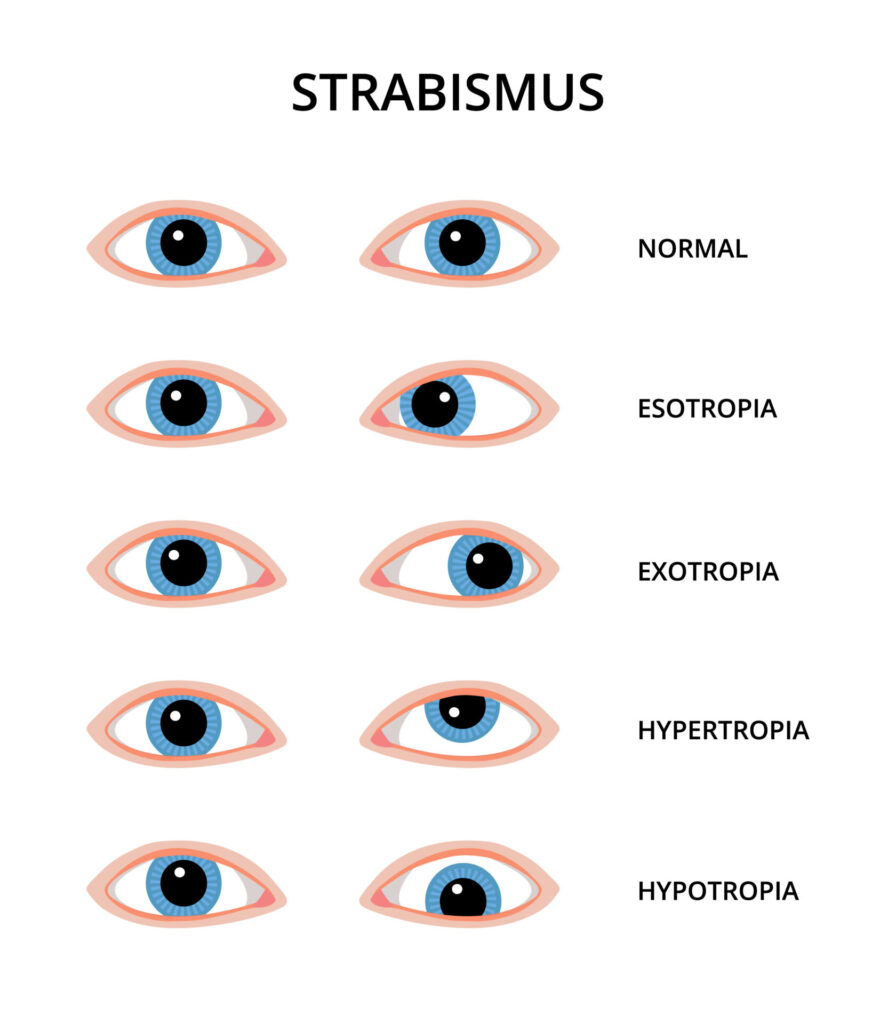Do you know how many muscles your eyes depend on for proper movement and function? There are 12 muscles total (six per eyeball) that must work together to ensure the eyes line up correctly, move in tandem, and overall function properly. If there is an issue with any one or more of the 12 muscles, it can result in strabismus, a condition wherein the eyes are misaligned.
But a muscle complication is not the only possible reason a person’s eyes are not lining up. Strabismus can be a result of any of the following issues:
- Muscle malfunction
- Attached nerve problems
- A malfunction in the part of the brain that controls the eyes and eye movements
For some patients, strabismus is an issue that develops in childhood. For others, it can start well into adulthood, even in old age.
What Are the Types of Adult Strabismus?
Whether you developed strabismus as a child or developed it as an adult, there are four primary types of strabismus a patient can experience:
- Esotropia, which causes the eye(s) to turn inward (commonly known as crossed eyes)
- Exotropia, which causes the eye(s) to turn outward (commonly known as walled eyes)
- Hypertropia, which causes an eye to point upward
- Hypotropia, which causes an eye to point downward
For many, the direction in which the eye or eyes point can depend on which eye muscle is weakened or malfunctioning.

What Causes Someone to Develop Adult Strabismus?
There are a number of causes for adult-onset strabismus, most of them having to do with aging and getting older. As the body ages, muscles, tendons, and ligaments can sometimes wear down, even in the eyes. Should any of your eye muscles start to weaken, it could result in the development of strabismus.
All possible causes of adult strabismus include:
- Weakened muscles due to age
- Aftereffects of a stroke
- Loss of blood circulation to the eyes, eye muscles, or nerves due to hypertension or diabetes
- Damage due to a head injury
- Return of strabismus if it was present in childhood
What Are the Signs of Adult Strabismus?
If a case of adult strabismus is mild enough, it can be difficult to recognize the misalignment just by looking at yourself in the mirror or looking at the patient straight on. If it is more pronounced or severe, it will likely be noticeable to the naked eye. But whether the eyes indicate the development of strabismus or not, one definite warning sign is sporadic or consistent double vision.
When a child develops strabismus, their forming brain learns to ignore the less dominant eye and relies solely on the dominant one for vision. The brain will suppress the image received from the less dominant eye, rendering it essentially useless.
However, if your brain has depended on both eyes throughout your childhood and adulthood, but one eye suddenly moves out of alignment, the brain will continue to receive vision from both eyes, causing images to appear doubled.
Symptoms of adult strabismus include:
- Depth perception issues
- Double vision
- Eyes that fail to move with one another
- Excessive blinking or squinting
- Misaligned eyes
- Sensitivity to bright sunlight
If I Develop Strabismus, Can I Still See?
Patients with adult strabismus can see, but their vision is distorted either mildly or significantly depending on the severity of the misalignment. For some, their vision becomes slightly off; for others, their vision can become so distorted that they lose their ability to perform everyday functions like walking, driving a car, cooking, and more.
So, should you develop adult strabismus, you will be able to see, but the quality of your vision will decline to some extent.
How Is Adult Strabismus Diagnosed?
Your ophthalmologist or optometrist can diagnose strabismus during a comprehensive eye exam. Your exam will include testing such as:
- Acuity test
- Refraction test
- Alignment and focusing tests
- Ocular health test
In addition to your regular eye exam, your doctor will likely ask you to cover each eye one at a time. If your double vision stops with an eye covered, that can indicate strabismus.
Can Adult Strabismus Be Treated?
There are ways to treat or manage adult strabismus, from specialty eyewear to surgery.
- Natural correction: You could observe your strabismus resolve on its own.
- Corrective eyewear: You may benefit from specialty eyeglasses wherein one of the lenses is opaque to block vision from the misaligned eye. Additionally, there are specialty prism glasses that bend light in such a way that the images received by each eye are realigned so that the brain interprets one clear image rather than two disjointed ones.
- Vision therapy: Vision therapy may be a viable option to help restrengthen the eye muscles or nerves affecting the eyes. Your eye doctor or vision therapist will offer exercises for your eyes to help them team back up, move in harmony, and focus better together.
- Surgery: There are surgical options to help change the length or position of problematic eye muscles to help your eyes regain alignment. Patients who undergo surgery will also need vision therapy to strengthen the muscles following the operation.
Have you started developing double vision or depth perception issues? Share your concerns about adult strabismus with the team at Vision Eye Group.
The ophthalmologists and optometrists at Vision Eye Group can perform thorough testing to evaluate your eyes and detect misalignment. If we determine the development of adult strabismus, we will begin a treatment plan as soon as possible to help strengthen your eyes, promote correct alignment, and reestablish strong vision. Please schedule an appointment with our team today: 478-744-1710
Recent Articles
